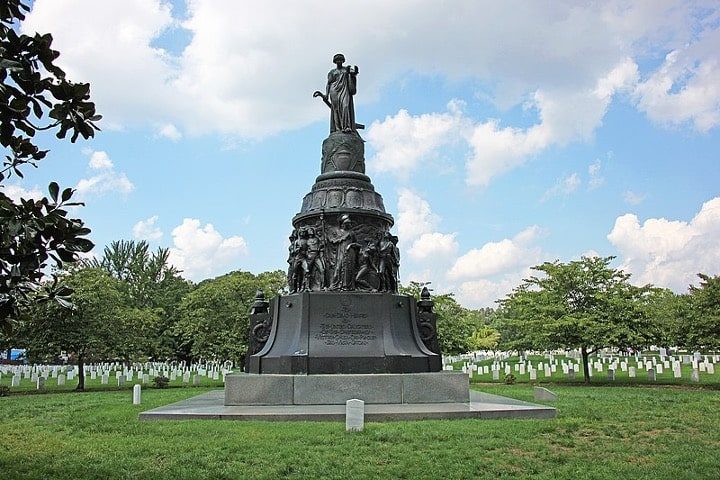
In a powerful statement against the idea of “reconciliation,” the federal government removed the monument to Confederate war dead on Wednesday. The monument, with no official name, has been variously called the Confederate Monument and the Reconciliation Monument. It was erected at Arlington National Cemetery over 100 years ago, and is surrounded by the graves of Confederate soldiers, in an effort to mark the reunification and reconciliation of the nation after the Civil War.
The base is expected to remain, for now, so as not to disturb surrounding graves, with the rest of the monument to be relocated to the New Market Battlefield State Historical Park in Virginia.
When President Joe Biden delivered his inaugural address on January 20, 2021, the central theme of his speech was, ironically enough, “unity.” Biden said that his “whole soul” was in “bringing America together … uniting our people … uniting our nation.”
“I know speaking of unity can sound to some like a foolish fantasy,” Biden added. “I know the forces that divide us are deep and they are real.”
With the removal of a monument dedicated to the idea of unity and “uniting our nation,” it appears that the “forces that divide us” include President Biden himself and those on the Left who reject any efforts at reconciliation. Instead, with actions like this, what is being implemented is the Marxist concept of division through racial hatred, sectional hatred, hatred between sexes, and any other grievances — real or imagined — that can tear the country apart.
In a recent article for The New American on the looming prospect of the removal of this reconciliation monument, R. Cort Kirkwood predicted that “within 10 years, remains of Confederate dead buried at Arlington National Cemetery will be exhumed and either desecrated, reburied elsewhere, or cast into the sea.” Kirkwood added that federal law requires the Department of Defense to “destroy anything Confederate connected with the U.S. military,” noting that West Point had “erased the memory of Robert E. Lee.”
That is especially ironic, considering that Arlington Cemetery is located on land essentially stolen from Lee by the federal government during the Civil War. The plantation and Arlington House were built by George Washington Parke Custis, the step-grandson of George Washington. (Washington and his wife, Martha, raised him as their own son after the death of Custis’ father). Custis had one daughter, Mary Anna Randolph Custis, who married Robert E. Lee.
Upon the death of Lee’s father-in-law in the late 1850s, Lee and his wife inherited the estate, which included slaves. Lee had written a letter to his wife from a military assignment at a fort in Texas a few years earlier, in which he expressed hope that God, in His providence, would choose to end slavery in America. After Lee inherited Arlington, with its slaves, he also inherited enormous debts. However, he refused to sell off the slaves, in part or in whole, but rather wished to pay off the estate’s debts and free them — both of which he did a few years later.
After the Civil War began, with Lee serving in the Confederate army, his wife, Mary, left the plantation. It was soon occupied by Union troops, and much of her personal property was stolen by them. When she sent an agent to pay the property taxes, federal officers refused to allow it. They demanded Lee come and pay the taxes in person — a ridiculous and illegal demand. Using the spurious argument that the taxes had not been paid, a tax sale was conducted and the federal government confiscated Arlington, where they soon began burying Union war dead. Some Confederate soldiers, including prisoners of war and battlefield dead, were also buried at Arlington.
In 1882, the Supreme Court ruled that the property had been illegally confiscated without due process. The estate was returned to the Lees’ son, who then sold it back to the government.
In 1898, the Spanish-American War was fought by soldiers from all the states, including those formerly in the Confederacy. (Even a few Confederate veterans fought in the brief war). This led President William McKinley, a Union war veteran himself, to give a speech — known as a “tribute to American valor” — celebrating the end of sectionalism. Many in the South took this as a gesture of reconciliation. McKinley soon approved of the movement to disinter Confederate dead at Arlington and rebury them in one Confederate section.
This was followed by Senator Joseph Roswell Hawley — a major general in the Union army during the war — introducing a bill in Congress to rebury the Confederates at Arlington. The United Daughters of the Confederacy began raising funds to establish a memorial in the Confederate section, and Secretary of War William Howard Taft gave his permission for the erection of a memorial.
Moses Jacob Ezekiel, a Jewish Confederate veteran who later became a Christian minister, was commissioned to design the memorial, which he considered the most important work that he had ever done. Speakers at the laying of the cornerstone on November 12, 1912, included three-time Democratic nominee for president William Jennings Bryan, and James Tanner, a former commander of the Grand Army of the Republic (organization of Union veterans). Tanner had lost both legs in the war.
At the top of the memorial, a woman represents the South. Her head is crowned with an olive wreath (a symbol of peace), and her right hand holds a pruning hook and rests on a plow (inspired by the biblical book Isaiah in chapter two, verse four, a verse about peace and reconciliation). Of course, this was removed on Wednesday.
The base had words honoring the Confederate war dead: “Not for fame or reward, not for place or for rank, not lured by ambition or goaded by necessity, but in simple obedience to duty as they understood it. These men suffered all, sacrificed all, dared all — and died.”
Today, in addition to creating a narrative of an oppressing class and an oppressed class — classic Marxist propaganda — denigrating brave Confederate soldiers (95 percent of whom owned no slaves at all) is a tactic to keep our fellow black Americans in the Democratic Party fold. Current events are now re-interpreted in a radical Marxist construct. Rather than seeking reconciliation between North and South, between the sexes, between different ethnic groups, and between those of different economic conditions, the Marxist strategy is to divide us and advance their radical agenda.
From the days of the French Revolution through the Cultural Revolution in Communist China, this agenda preaches hate and division. It is anti-Christian at its core. Of course, Karl Marx hated all religion, especially Christianity and Judaism. The intention of Marx’s modern followers — whatever they happen to call themselves — is to destroy all existing institutions of society, such as religion and the family, so as to substitute a totalitarian society much like that envisioned in George Orwell’s dystopian novel 1984.


